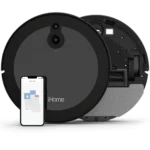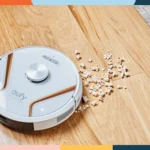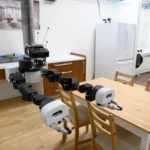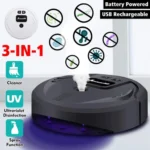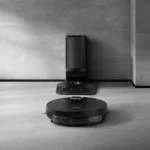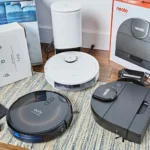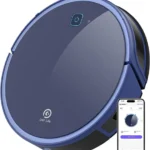Imagine coming home to a clean and dust-free living space without ever having to lift a finger. It sounds like a dream, but with the emergence of smart vacuum cleaners, it is becoming a reality. These innovative devices have revolutionized the way we clean our homes, and at the heart of this technology lies the power of artificial intelligence (AI). But what exactly is AI, and how is it transforming smart vacuum cleaners into intelligent and efficient cleaning machines? In this article, we will delve into the world of AI in smart vacuum cleaners, exploring its benefits and limitations, and offering insight into where this technology is headed in the future.
What is AI?
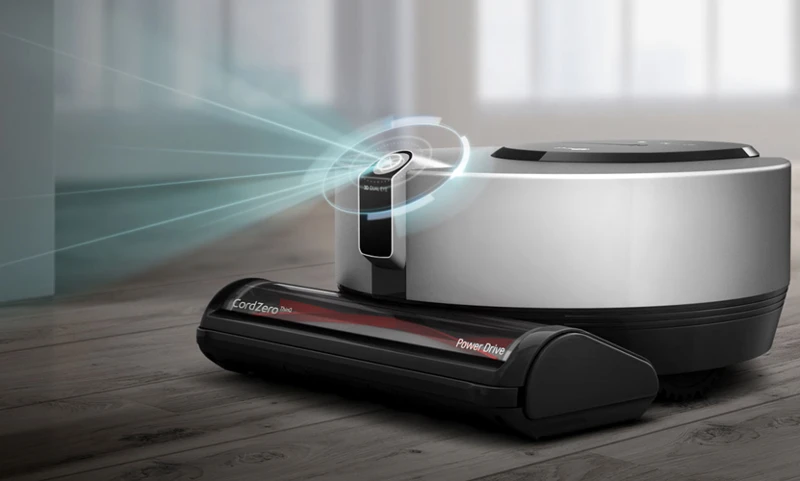
The term “AI” has become a buzzword in recent years, but what does it really mean? AI stands for “artificial intelligence,” which refers to machines that are capable of performing tasks that usually require human intelligence, such as learning, reasoning, and problem-solving. AI is a broad term that covers various technologies and applications, and in this article, we’ll explore how AI is used in smart vacuum cleaners. If you’re curious about the pros and cons of different types of vacuum cleaners, check out our guide here.
The Basics
Artificial intelligence (AI) is becoming increasingly popular and prevalent in many smart home devices, including smart vacuum cleaners. To understand the role of AI in smart vacuums, it’s important to first understand the basics of AI.
Artificial intelligence (AI) refers to the development of computer systems that can perform tasks that typically require human intelligence, such as visual perception, speech recognition, decision-making, and language translation.
There are several types of AI that are commonly used in smart devices, including:
| Type of AI | Description |
|---|---|
| Rule-based systems | These systems are programmed to follow a set of predetermined rules and respond to specific inputs in prescribed ways. |
| Machine learning | These systems use data and algorithms to learn and improve their performance over time. |
| Natural language processing (NLP) | These systems enable machines to understand and interpret human language and respond in natural ways, such as voice commands or text-based chatbots. |
Machine learning is a subfield of AI that refers to the use of data and algorithms to train and improve computer systems’ ability to perform specific tasks. Machine learning algorithms can learn from historical data and adjust their performance dynamically based on new data inputs. This type of AI is commonly used in smart vacuum cleaners for floor mapping and obstacle detection.
Natural language processing (NLP), on the other hand, refers to the use of computer algorithms and statistical models to analyze and interpret natural language, such as spoken or written text. NLP is commonly used in smart vacuum cleaners that offer voice control and integration with smart home systems.
In the next section, we’ll explore how AI is specifically used in smart vacuum cleaners for tasks such as obstacle detection, floor mapping, and voice control.
Internal link: If you would like to learn more about how to choose the right smart vacuum cleaner, check out our smart vacuum cleaner choosing tips.
Machine Learning
Machine learning is a subset of AI that involves the use of algorithms and statistical models to enable machines to learn from data and improve their performance over time. In the case of smart vacuum cleaners, machine learning is used to enable these devices to recognize and respond to different types of surfaces, debris, and obstacles in a home environment.
One of the key advantages of machine learning is that it allows smart vacuum cleaners to adapt to changing environments and cleaning needs. As the device gathers more data about a particular space, it becomes better equipped to anticipate future cleaning tasks and optimize its cleaning patterns accordingly.
To achieve this, machine learning algorithms use a number of statistical techniques, such as decision trees, neural networks, and clustering. These techniques enable smart vacuum cleaners to detect and classify different types of debris, such as dirt, pet hair, and crumbs, and adjust their suction power and cleaning patterns accordingly.
Machine learning can also be used to improve the accuracy of obstacle detection and avoidance. By analyzing the dimensions and layout of a room, smart vacuum cleaners can identify potential obstacles, such as furniture and walls, and plan their cleaning routes accordingly to avoid collisions.
However, while machine learning has many benefits in the context of smart vacuum cleaners, it also has its limitations. One of the biggest challenges is ensuring that the algorithms and statistical models used by the device are accurate and reliable. Inaccurate or incomplete data can lead to poor cleaning performance and reduced efficiency.
To overcome these challenges, manufacturers of smart vacuum cleaners must invest in ongoing testing and improvement of their machine learning algorithms. This can involve collecting additional data about home environments and cleaning patterns, as well as developing more sophisticated algorithms and statistical models.
Machine learning is a key component of the AI technology used in smart vacuum cleaners, enabling these devices to adapt to changing environments and optimize their cleaning performance over time. However, ongoing investment and improvement are necessary to ensure that these algorithms remain accurate and reliable, thus delivering the full benefits of machine learning to consumers.
Natural Language Processing
Natural Language Processing (NLP) is a subfield of AI that focuses on enabling machines to understand and interpret human language. It allows smart vacuum cleaners to respond to voice commands and interact with users in a more natural way. With NLP, smart vacuums can learn to recognize different languages, accents, and speech patterns, making them more accessible to a global market.
One of the key applications of NLP in smart vacuums is voice control. Voice control enables users to control the cleaning process using simple voice commands. For example, users can ask their smart vacuum to start cleaning a specific room or to return to its charging dock. This feature makes cleaning more convenient and accessible, especially for people with disabilities or mobility issues.
In addition to voice control, NLP also allows smart vacuums to provide feedback and updates to users through spoken or written messages. For example, if the vacuum encounters an obstacle or has trouble navigating a certain area, it can inform the user through a spoken message or push notification.
Another important benefit of NLP is its ability to improve accuracy and efficiency in cleaning. With the help of NLP, smart vacuums can learn to recognize different types of floor surfaces and adjust their cleaning settings accordingly. They can also “remember” the layout of a room and navigate around furniture or obstacles more efficiently.
However, NLP also has its limitations and challenges. One of the biggest challenges is the accuracy of speech recognition, especially in noisy environments or with non-native speakers. Additionally, some users may be concerned about their privacy and the potential for their voice commands to be recorded or stored.
Natural Language Processing is an important tool that has enabled smart vacuum cleaners to become more user-friendly and efficient. As technology continues to advance, NLP is likely to become even more advanced and widespread in smart home devices. To learn more about the future of smart vacuums, check out our article on future smart vacuum technology.
How AI is Used in Smart Vacuum Cleaners
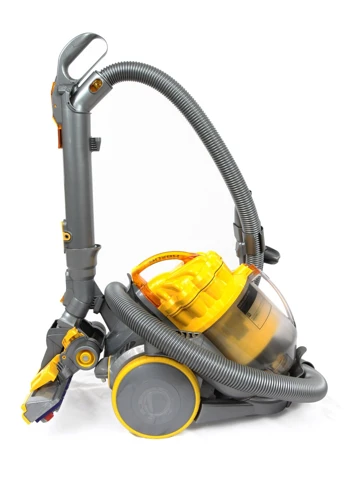
As technology continues to advance, smart home devices are becoming increasingly popular. Smart vacuum cleaners, in particular, have come a long way with the incorporation of artificial intelligence (AI). With the ability to detect and navigate obstacles, map out floor plans, and even be controlled through voice commands, AI has greatly enhanced the performance and functionality of smart vacuum cleaners. Let’s explore the various ways in which AI is used in smart vacuum cleaners. And if you’re interested in the maintenance of these devices, check out our smart vacuum cleaner maintenance tips guide.
Obstacle Detection
One of the most important features of smart vacuum cleaners is their ability to detect obstacles in their path using AI technology. This feature enables the vacuum cleaner to navigate around furniture, toys, and other objects on the floor without bumping into them or causing damage.
The obstacle detection technology is based on various sensors and cameras that capture the surroundings of the vacuum cleaner, allowing it to understand the layout of the space it is cleaning. Some smart vacuum cleaners use a combination of infrared sensors, laser sensors, and cliff sensors to navigate around the obstacles. These sensors can detect the size, distance, and height of the objects in front of the vacuum cleaner and adjust its path accordingly.
Another type of obstacle detection technology that is gaining popularity in smart vacuum cleaners is the use of cameras and computer vision algorithms. The vacuum cleaner uses a camera to capture images of the environment, and the computer vision algorithm analyzes the images to identify obstacles and determine their position and size. This technology allows the vacuum cleaner to detect not only stationary objects but also moving objects such as pets, and it can adjust its path in real-time to avoid collisions.
The benefits of obstacle detection technology in smart vacuum cleaners are clear:
- Reduces the risk of damage to furniture and other objects on the floor
- Improves the efficiency and speed of cleaning by preventing the vacuum cleaner from getting stuck or having to backtrack
- Enhances the safety of the vacuum cleaner by preventing it from falling down stairs or off ledges
Despite these advantages, there are also some challenges and limitations related to obstacle detection technology in smart vacuum cleaners. One such challenge is that the vacuum cleaner may not correctly recognize all types of obstacles, especially those that are partially hidden or have an irregular shape. Another limitation is that the more advanced obstacle detection technology, such as computer vision algorithms, can be costly and add to the overall cost of the vacuum cleaner itself.
The obstacle detection technology in smart vacuum cleaners is a crucial part of their functionality and has numerous benefits for efficiency, safety, and damage prevention. As this technology advances further, smart vacuum cleaners will become even more effective and will continue to improve the cleaning experience for homeowners.
Floor Mapping
Smart vacuum cleaners that utilize artificial intelligence (AI) technology have become increasingly popular in recent years. One of the most impressive features of these devices is floor mapping.
Floor mapping is the process by which a smart vacuum cleaner creates a map of the home or space it is cleaning. This allows it to navigate more effectively and efficiently, saving time and ensuring that every area of the floor is covered.
To achieve accurate floor mapping, smart vacuum cleaners use a variety of sensors and technologies, including cameras, LIDAR, and infrared sensors. These sensors allow the vacuum to determine its exact position and orientation relative to the surrounding environment. By combining this information with data on the size and layout of the room, the vacuum can create a highly accurate map that it can use to navigate the space.
The benefits of floor mapping are clear. For one, it allows the vacuum cleaner to clean more efficiently, as it can move in a logical, optimized pattern that ensures that every inch of the floor is covered. Additionally, it can prevent the vacuum from wasting time cleaning areas where it has already been or missing areas altogether.
There are also potential benefits for users. By using a smart vacuum cleaner that can create a map of the home, users can gain insights into how their living space is being used. For example, they may notice that certain rooms are consistently dirtier than others or that there are areas that are frequently missed by the vacuum. This information can help them adjust their cleaning routines or even rearrange furniture to optimize the space.
However, there are also challenges associated with the use of floor mapping in smart vacuums. For one, the technology required to create accurate floor maps is complex and expensive, which can make these devices out of reach for some consumers. Additionally, there are concerns related to privacy and security, as the maps created by these devices could potentially be used to gather data on users’ living spaces. It is important for manufacturers to address these issues as they continue to innovate and develop new smart vacuum cleaning products.
Floor mapping is one of the most exciting and innovative features of AI-powered smart vacuum cleaners. While there are certainly challenges associated with implementing this technology, the benefits it offers in terms of efficiency, accuracy, and user insights make it a valuable tool for anyone looking to keep their floors clean.
Internal link: To learn more about the environmental impact of smart vacuum cleaners, check out our article on the environmental impact of smart vacuum cleaners.
Voice Control and Integration with Smart Home Systems
Smart vacuum cleaners have revolutionized the cleaning industry. One of the most exciting advancements in AI technology is the integration of smart vacuum cleaners with voice control and smart home systems. This integration allows the user to control the vacuum cleaner using voice commands and smart devices, making the cleaning process more convenient and efficient.
Voice Control: With voice control, the user can simply tell the vacuum cleaner to start or stop cleaning, change the cleaning mode, or even schedule cleaning times. This is particularly helpful for individuals who have difficulties with mobility or who have busy schedules. For example, a person who is cooking or doing some activity that makes it hard to use physical buttons can verbally command the vacuum cleaner to start cleaning the floors. Voice control can be integrated with virtual assistants like Amazon Alexa, Google Assistant or Apple Siri, providing users with the ability to control the vacuum cleaner using their voice.
Integration with Smart Home Systems: Smart vacuum cleaners can be integrated with other smart home devices through the internet of things (IoT) technology, like smart thermostats, smart security cameras, and smart lighting systems. This integration allows for more efficient and synchronized automation of household tasks. For example, when the user leaves the house or sets the alarm at night, the smart vacuum cleaner can start cleaning the floors automatically, so that the user always comes back to a clean home. The vacuum cleaner can be programmed to stop cleaning when it detects motion, therefore avoiding possible accidents.
While the integration of AI technology with voice control and smart home systems is exciting, there are still some challenges to be addressed. One such challenge is the reliability of the connection between the vacuum cleaner and the smart home system. If the connection is poor or if there is a power outage, the vacuum cleaner will not receive instructions from the smart home system, affecting its effectiveness.
The integration of smart vacuum cleaners with voice control and smart home systems has great potential to make household cleaning more convenient and efficient. As technology continues to advance and challenges are addressed, we can expect to see more and more smart home devices being integrated together for an even more connected and automated home experience.
Benefits of AI in Smart Vacuum Cleaners
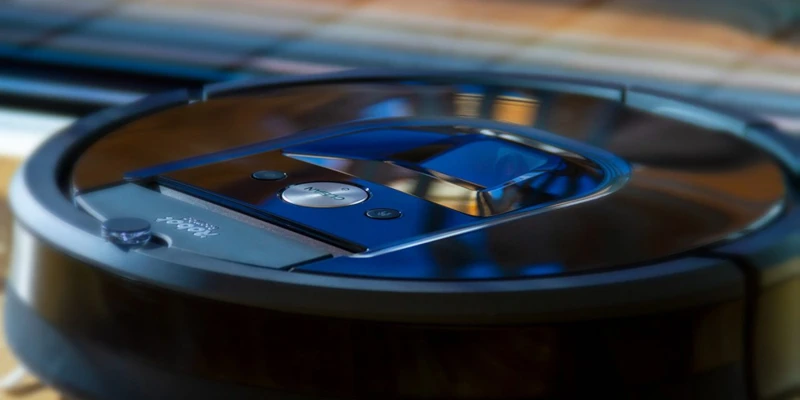
The implementation of Artificial Intelligence (AI) in smart vacuum cleaners has revolutionized the way we clean our homes. The use of AI technology brings numerous benefits that traditional vacuum cleaners lack. The combination of advanced sensors and intelligent algorithms has resulted in an efficient and personalized cleaning experience like never before. Let’s look at some of the key advantages of using AI in smart vacuum cleaners that have led to their growing popularity among homeowners. From improved efficiency to better cleaning performance and customization options, AI-powered vacuums open up new possibilities in our cleaning routines.
Efficiency and Time-Saving
Smart vacuum cleaners equipped with Artificial Intelligence (AI) technology offer various benefits including improved efficiency and time-saving capabilities. AI technology enables the vacuum cleaners to learn, adapt, and optimize their cleaning patterns to suit the specific needs of your home. By analyzing the layout of your home and mapping the cleaning areas, these devices can navigate through your home without missing any spots, leading to a quicker and more effective cleaning experience.
Here are some specific ways in which AI improves efficiency and saves time:
- Automated Cleaning: With AI technology, smart vacuum cleaners can automate cleaning patterns without any human input. This frees up time for homeowners to focus on other household tasks or simply relax.
- Optimized Navigation: AI-powered smart vacuum cleaners can optimize their navigation by analyzing the layout of your home and finding the most efficient routes for cleaning. This reduces cleaning time and saves energy by not overlapping cleaning lines.
- Targeted Cleaning: Smart vacuum cleaners with AI capabilities can identify areas of high traffic which require more frequent cleaning. They can also detect hard-to-reach areas such as corners or under furniture, and focus on cleaning those areas first.
- Scheduling Cleaning Tasks: With scheduling features, AI-powered smart vacuums can be programmed to clean at specific times. This ensures that your home is always clean and tidy without any added effort on your part.
Smart vacuum cleaners with efficient battery management systems can operate for longer periods of time, leading to increased productivity and less downtime. This eliminates the need for frequent charging, making these devices even more convenient and time-saving.
However, it is important to note that AI-powered smart vacuum cleaners may come with a higher price tag compared to traditional vacuum cleaners. Nonetheless, with the increasing demand for these devices and the advancement of AI technology, it is predicted that the future will see more affordable options becoming available.
Smart vacuum cleaners featuring AI technology offer improved efficiency and time-saving capabilities. By optimizing navigation, targeting cleaning, and automating cleaning patterns, they ensure a quicker and more effective cleaning experience.
Customization and Personalization
One of the most interesting applications of AI in smart vacuum cleaners is the ability to customize and personalize cleaning performance to meet the specific needs of the user. With advanced sensors and machine learning algorithms, smart vacuums can adapt to individual households and spaces.
Customized Cleaning Plans: Smart vacuum cleaners allow users to set customized cleaning plans by specifying cleaning times or boundary lines that the device shouldn’t cross. This feature ensures that cleaning happens only when it’s convenient for the user, and that the vacuum sticks to designated cleaning areas.
Adjustable Suction Levels: Another way in which these vacuums adapt to individual households is by adjusting suction levels for different surfaces. With advanced sensors, these devices can detect the type of floor they’re on, and adjust suction power accordingly. Users can also manually set suction levels, allowing them to clean delicate surfaces without causing any damage.
Personalized Cleaning History: Smart vacuum cleaners also come with a feature that provides users with cleaning history details. This feature allows the user to view exactly which areas have been cleaned and how long it took to clean them. This allows users to customize cleaning plans and adjust suction levels to illuminate any cleaning-related problems they may encounter in the future.
| Customization and Personalization | Description |
|---|---|
| Customized Cleaning Plans | Users can set customized cleaning plans with pre-defined cleaning times, boundary lines that the device shouldn’t cross, and other options. |
| Adjustable Suction Levels | The vacuum cleaner adjusts suction levels for different types of surfaces and allows users to manually set suction levels for delicate surfaces. |
| Personalized Cleaning History | The device stores information about which areas have been cleaned and how long it took to clean them. This allows users to customize cleaning plans and adjust suction levels for future cleaning. |
With these customization and personalization features, smart vacuums are quickly becoming one of the most versatile and efficient cleaning devices in the market. However, it is important to note that such advanced features increase the cost of smart vacuums. Additionally, the reliability and maintenance of such vacuums need to be considered before making a purchase decision.
Improved Cleaning Performance
One significant advantage of artificial intelligence (AI) in smart vacuum cleaners is the improved cleaning performance. The use of AI technology enables these devices to perform higher levels of cleaning accuracy, enabling them to remove more dirt and dust in less time.
One of the main ways AI contributes to the improved cleaning performance of smart vacuums is through floor mapping. By using sensors and cameras, smart vacuums can create a map or layout of the room they are cleaning, enabling them to navigate around obstacles and reach every corner or crevice with ease. They can even adjust their suction power based on the type of surface they’re cleaning.
Another way AI contributes to improved performance is through obstacle detection. Smart vacuums use various sensors to detect obstacles like furniture or walls, and then adjust their cleaning path accordingly to avoid collisions. This feature also improves safety by preventing damage to the vacuum cleaner or any obstacles in the way.
Lastly, the voice control and integration with smart home systems feature of smart vacuums enables you to control them using voice commands, remote control, or through an app on your smartphone. This feature allows for customization of the cleaning process and scheduling, enabling you to designate areas that require additional cleaning, or schedule cleaning in specific rooms based on your preference.
AI-based smart vacuums offer more personalized and efficient cleaning than traditional vacuum cleaners, saving both time and energy. However, these smart vacuums often come with a higher price tag and may require maintenance such as battery management and cleaning. It is worth exploring the different types of vacuum cleaners available, such as handheld and stick vacuums before making a decision on which one to acquire.
Challenges and Limitations of AI in Smart Vacuum Cleaners
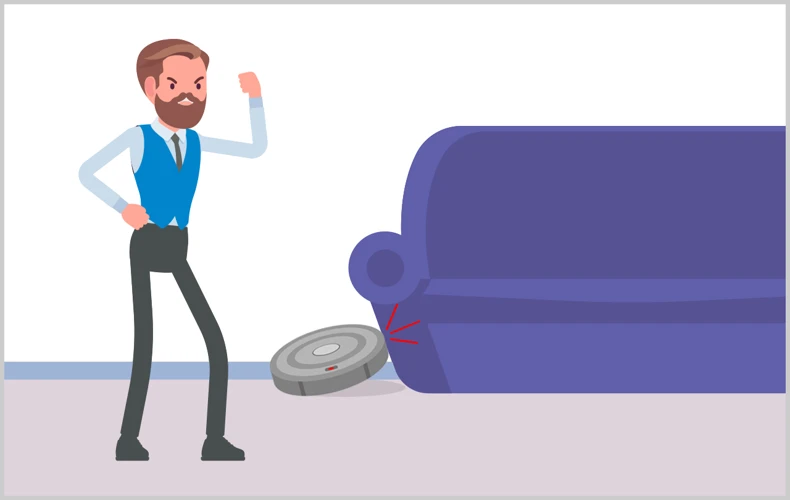
As with any technology, there are certain challenges and limitations that need to be considered when it comes to the use of artificial intelligence in smart vacuum cleaners. While AI has undoubtedly brought about many advancements in the field of household cleaning, there are still a number of issues that must be addressed in order to fully realize its potential. In this section, we will explore some of the most pressing challenges and limitations associated with the use of AI in smart vacuum cleaners, from the cost and affordability of these devices, to concerns around privacy and security, to the need for ongoing maintenance and reliability.
Cost and Affordability
As with any emerging technology, cost and affordability are significant concerns for smart vacuum cleaners utilizing AI. While the benefits of AI are substantial, the high cost of manufacturing and development is a significant challenge that manufacturers face. Not all households can afford smart vacuum cleaners, preventing the widespread adoption of this technology.
Factors affecting the cost of AI in Smart Vacuum Cleaners
Several factors contribute to the cost of AI-enabled smart vacuum cleaners. These factors include:
| Factor | Description |
| Hardware Components | The cost of cutting-edge sensors, cameras, wireless connectivity modules, and other necessary hardware components required to integrate AI features adds up to the final product cost. |
| Software Development | The expense of hiring software developers and AI engineers to design, develop, and maintain the complex algorithms and machine learning models that power AI-enabled smart vacuum cleaners. |
| Research and Development | The cost of conducting research, testing, and development of new AI features and capabilities for smart vacuum cleaners adds additional costs to the manufacturing process. |
| Brand Name | The reputation and recognition of the brand name can affect the pricing of smart vacuum cleaners. Established brands may charge a premium for their product due to their reputation, whereas lesser-known brands may charge a lower price to attract more customers. |
Impact on Affordability and Consumer Adoption
The high cost of AI-enabled smart vacuum cleaners has a significant impact on consumer adoption. The technology is still relatively new, which means the costs of manufacturing and development are high. It is also perceived as a luxury product, making it unreachable for many households. As a result, the market share of smart vacuum cleaners is relatively small compared to non-AI enabled vacuum cleaners.
The cost of maintenance and repairs of smart vacuum cleaners can be high, especially if the product warranty period has expired. The high cost of ownership of the product can deter potential customers from investing in AI-enabled smart vacuum cleaners.
Conclusion
Cost and affordability are major challenges that hinder the adoption and growth of AI-enabled smart vacuum cleaners. While the benefits of AI are substantial, manufacturers must consider the high cost of manufacturing and development before releasing their products to the market. In the future, technological advancements and increased competition may lead to a reduction in the cost of AI-enabled smart vacuum cleaners, making them more accessible to households.
Privacy and Security Concerns
With the advent of AI technology in smart vacuum cleaners, it is vital to consider privacy and security concerns that come with it. While the technology allows for seamless cleaning and automation, users must be aware of the potential risks associated with using these devices.
Privacy concerns arise because smart vacuum cleaners are embedded with various sensors and cameras that record and store data such as home layout, cleaning schedule, and user habits. This data is then stored within the device or sent to cloud servers for analysis and optimization purposes. However, this data collection raises concerns about who has access to this information and how it might be used.
Security concerns are also relevant as these devices are connected to Wi-Fi and can be controlled remotely via a mobile app. This openness makes them susceptible to hacking, giving cybercriminals access to sensitive data or even control of the device itself. Malware or viruses can also be inserted through these devices, leading to unauthorized access, data breaches, or even system failure.
To address these concerns, manufacturers must prioritize security measures and prioritize user privacy. This can be achieved by implementing strict data encryption, two-factor authentication, and regular software updates to mitigate newly discovered vulnerabilities. Users must also ensure that their Wi-Fi networks are secure, and their passwords are robust to prevent unauthorized access.
Here are some potential privacy and security concerns that may arise when using AI in smart vacuum cleaners:
| Privacy Concerns | Security Concerns |
|---|---|
| Data collection and storage | Potential hacking |
| Access to sensitive information | Malware or virus insertion |
| Potential data breaches | System failures |
As AI technology continues to evolve, it is essential to prioritize privacy and security solutions to make tech-driven devices safer and reliable for consumers. Manufacturers must prioritize security measures, and users must be aware of potential threats and protect their devices and networks.
Reliability and Maintenance
Maintaining the reliability of Smart vacuum cleaners that use AI technology is essential to ensure optimal performance. While these devices are designed to function autonomously, they still require regular maintenance to avoid mechanical failures and ensure they operate as expected.
Maintenance and cleaning are both essential factors for keeping smart vacuum cleaners running at their best. Regular cleaning of the vacuum’s brushes and filter will prevent dirt and debris from clogging the system, while replacing damaged parts will help prevent further wear and tear.
Besides, the reliability of AI in smart vacuum cleaners also depends on the quality of materials used in its construction. A reliable device must be made with durable and long-lasting materials to ensure that it can withstand the wear and tear of daily use.
Keeping the software up-to-date is crucial for the proper functioning of AI technology in smart vacuum cleaners. Manufacturers often update their software to fix bugs, enhance their features and improve overall device functionality. Failing to update the device regularly will lead to reduced performance, security vulnerabilities, and a shorter lifespan of the product.
In addition to maintenance, user error is another factor that can impact the reliability of AI technology in smart vacuum cleaners. Suppose a user accidentally drops the device or uses it in a way not intended by the manufacturer. In that case, it can cause significant damage to the machine and reduce its lifespan. It is essential to read the user manual before using the product and follow the manufacturer’s instructions carefully.
Table:
| Reliability and Maintenance |
|---|
| Regular cleaning of the vacuum’s brushes and filter |
| Replacing damaged parts |
| Use of durable and long-lasting materials |
| Regular software updates |
| Read user manual and follow the manufacturer’s instructions carefully |
Maintaining the reliability of smart vacuum cleaners that use AI technology involves regular cleaning, replacing damaged parts, using durable materials, keeping software up-to-date, and following the manufacturer’s instructions carefully. By taking these measures, users can ensure their device’s optimal performance and extend its lifespan.
The Future of AI in Smart Vacuum Cleaners
The era of Smart Vacuum Cleaners is upon us, and with the integration of AI technology, they have become more efficient and intelligent than ever before. As we look towards the future of these machines, it is clear that even more advancements are on the horizon. The future holds great promise for AI in Smart Vacuum Cleaners, and will undoubtedly revolutionize the way we clean our homes. Let’s take a closer look at some of the exciting possibilities that we can expect in the coming years.
Advancements in AI Technology
As technology continues to advance at a rapid pace, it is no surprise that AI capabilities in smart vacuum cleaners are also improving. AI technology is becoming more sophisticated and powerful, leading to more efficient and effective smart vacuum cleaners.
Here are some advancements in AI technology that have been integrated into smart vacuum cleaners:
| Advancement | Description |
|---|---|
| Deep Learning Algorithms | With deep learning algorithms, smart vacuum cleaners can learn from their past cleaning experiences and improve their performance. This technology allows the vacuum cleaner to analyze data and learn patterns over time, so it can continually improve its cleaning efficacy. |
| Intelligent Navigation Systems | Smart vacuum cleaners now have more intelligent navigation systems that make them better equipped to navigate complex floor plans. Sensors can detect the layout of the room and make adjustments accordingly, which allows the vacuum cleaner to clean around obstacles more effectively and optimize its cleaning path. |
| Object Recognition | AI-powered object recognition allows smart vacuum cleaners to detect different types of obstacles and adjust their cleaning behavior accordingly. For example, if the vacuum cleaner detects a pile of shoes, it may avoid that area altogether. |
| Real-Time Mapping | Smart vacuum cleaners now use real-time mapping to create a more accurate map of the room they are cleaning. This allows them to clean more efficiently and avoid cleaning the same area twice. |
| Voice Recognition | With voice recognition technology, smart vacuum cleaners can respond to voice commands from their owners. This allows for hands-free operation and more convenient cleaning experiences. |
These advancements in AI technology have made smart vacuum cleaners more efficient, effective, and easier to use. As AI technology continues to improve, we can look forward to even more capabilities being integrated into these devices.
Integration with Other Smart Devices and Appliances
The integration of smart vacuum cleaners with other smart devices and appliances is a key area where artificial intelligence is driving innovation, convenience and efficiency. Smart home technology is aimed at making life easier, and thanks to AI, these devices are becoming more intelligent and interconnected.
One example of the integration of smart vacuum cleaners with other devices is the ability to control them using voice commands through popular smart assistants such as Amazon Alexa and Google Assistant. This means that users can simply say “Alexa, clean the living room” or “Hey Google, start the vacuum” and the device will start cleaning without the need for physical interaction.
Another example is the connection with smart home systems, which allows users to control their vacuum cleaners using a mobile app from anywhere at any time. Via the app, they can start or stop the device, schedule cleaning sessions, or even monitor the cleaning progress in real-time.
Some smart vacuums can also integrate with smart cameras and sensors. For instance, when a camera detects a spill on the floor, it signals the vacuum to clean that area automatically. This seamless integration saves not only time but also reduces manual labor.
In addition to these convenient features, the integration of smart vacuums with other smart devices also opens up opportunities for automation and optimization. By connecting to other devices such as smart thermostats or lighting systems, the vacuum cleaner can work in tandem with these devices to provide a more comfortable and optimized living space for its users.
With the increasing interconnectedness of smart devices and appliances, it is not difficult to imagine a day when AI-powered smart vacuums can communicate with other devices to ensure they are avoiding areas with high foot traffic, for example, or working together to create the most efficient cleaning plan for a home.
The integration of smart vacuum cleaners with other smart devices and appliances offers users an exciting glimpse into the future of home automation and AI. These innovations allow for a more hands-off, seamless experience in home cleaning, and as the technology continues to evolve, the possibilities for automation and optimization are endless.
Increased Adoption and Accessibility
As the technology behind smart vacuum cleaners continues to evolve, increased adoption and accessibility of these devices is becoming more prevalent. There are several factors driving this trend, including:
- The decreasing cost of AI technology, making it more affordable for consumers
- Growing awareness and interest in smart home automation
- Advancements in battery technology, enabling longer cleaning times and faster charging
- Improvements in cleaning performance, resulting in more efficient cleaning and better results
Smart vacuum cleaner manufacturers are increasingly emphasizing ease of use and accessibility in their design and marketing strategies. Newer models often come equipped with advanced features, but are still user-friendly for individuals who may not be tech-savvy. For example, vacuum cleaners with voice control capabilities allow users to simply speak commands to the device, eliminating the need for complicated button pressing or programming.
Increased adoption and accessibility of smart vacuum cleaners is also being driven by the rising popularity of home automation systems. These systems allow for the integration of various smart devices, including vacuum cleaners, through a single, easy-to-use interface. This integration allows users to control all of their devices through one app, making automation and customizability easier than ever before.
As more consumers become familiar with the benefits of AI-powered vacuum cleaners, the demand for accessible and affordable options is sure to grow. To keep up with this trend, manufacturers will need to continue improving their products and designing them with accessibility in mind. Ultimately, this will make it easier than ever for users to enjoy the convenience and efficiency of smart vacuum cleaners in their homes.
Conclusion
In conclusion, the role of artificial intelligence in smart vacuum cleaners has revolutionized the way we clean our homes. From obstacle detection to floor mapping and even voice control, AI has definitely made our lives easier and more convenient. With the efficiency and time-saving benefits of AI, we can now spend more time doing things we love rather than cleaning.
However, there are also challenges and limitations that need to be addressed, such as cost, privacy and security concerns, and reliability and maintenance. Nevertheless, with the advancements in AI technology, the future of smart vacuum cleaners looks promising.
As AI continues to evolve and improve, we can expect even more integration with other smart devices and appliances, and increased adoption and accessibility, making it even easier for everyone to have a clean home without the hassle.
Overall, while there are still challenges and limitations to overcome, the benefits of AI in smart vacuum cleaners are undeniable, and it’s exciting to see where this technology will take us in the future. With AI-enabled devices becoming more and more popular, it’s clear that the role of AI in smart vacuum cleaners is just the beginning of a larger trend towards more efficient, customized, and personalized home cleaning.
Frequently Asked Questions
What makes a vacuum cleaner “smart”?
A smart vacuum cleaner has artificial intelligence technology implemented in its operation, allowing it to perform tasks autonomously and communicate with other smart devices.
What is obstacle detection in smart vacuum cleaners?
Obstacle detection is a feature in smart vacuum cleaners that uses sensors to detect and avoid obstacles such as furniture, walls, and stairs.
How does floor mapping improve the efficiency of smart vacuum cleaners?
Floor mapping allows a smart vacuum cleaner to accurately navigate and clean a room, ensuring that no spots are missed while minimizing overlap and reducing cleaning time.
What is the benefit of voice control and integration with smart home systems?
Voice control and integration with smart home systems allow users to control their smart vacuum cleaners using simple voice commands or through an app on their smartphone or other device, making cleaning even more convenient and effortless.
Can smart vacuum cleaners be personalized for individual cleaning needs?
Yes, smart vacuum cleaners offer the ability to customize cleaning schedules, choose specific cleaning modes, and even prioritize certain areas or rooms for cleaning.
How does AI improve the cleaning performance of smart vacuum cleaners?
AI allows smart vacuum cleaners to adapt and learn from the environment, optimizing cleaning patterns and adjusting power and suction levels based on the type of flooring and dirt level.
Are there any privacy concerns with using AI-powered smart vacuum cleaners?
Privacy concerns may arise if the smart vacuum cleaner has a camera or microphone, as these can potentially capture personal information. However, most smart vacuum cleaners do not have these features.
What are the limitations of AI technology in smart vacuum cleaners?
The cost of AI-powered smart vacuum cleaners may be prohibitive for some consumers, and they may also require regular maintenance and updates to ensure optimal performance.
What advancements can we expect in AI technology for smart vacuum cleaners in the future?
Advancements in AI technology for smart vacuum cleaners may include better sensors, increased processing power, and even more advanced machine learning capabilities.
Will smart vacuum cleaners become more prevalent in the future?
Yes, as more consumers adopt smart home technology and researchers continue to innovate in the field of AI, we can expect to see more widespread use of smart vacuum cleaners and other smart home devices.

